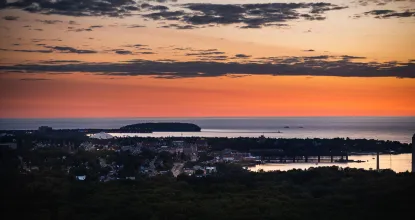The following facts on Upper Peninsula weather were gleaned from Richard A. Keen's book, Michigan Weather (Helena, MT: American & World Geographic Pub., 1993). This is a mere sampling of the UP's varied weather.
Variety of Weather
In 1897 the citizens of Marquette enjoyed a warm Easter (April 18) day but a cold front dropped the temperature from 60 degrees to 25 degrees. The Mining Journal noted the sudden change "gave even the oldest residents a fuller idea of the depth of total depravity to which Upper Peninsula weather can sink."
1917- Marquette harbor remained closed until May 17. Then there was a heat wave on July 29 when Marquette reached 105 degrees. In late December all time low -38 degrees at Bergland.
Lake Superior
Lake Superior is the deepest of the Great Lakes: 1,335 feet deep off of Munising. Below the surface the temperature remains 39 degrees year round. Lake Superior is 31,820 sq. miles at an elevation of 602 feet.
A seiche is defined as an oscillation of the surface of a lake or landlocked sea that varies in period from a few minutes to several hours. In 1834 a seiche hit Sault Ste. Marie and on June 18, 1939 a seiche traveled from L'Anse to Munising. Others hit Sault Ste. Marie on May 2, 1952 and Keweenaw Bay on June 30, 1968.
1986- peak level for the Great Lakes.
1926- due to dry weather Lake Superior drops to 1.8' below normal in April, its lowest level on record.
On occasion, Lake Superior has kept its ice into June (1972) and July (1876).
1963- late February, Lake Superior is iced up except for an acre or two.
1972- Lake Superior is reported to be 95% ice-covered.
During the winter of 1998 Lake Superior was covered with little ice.
Lake Superior normally gets no warmer than 53 degrees and usually not until August though bays and near-shore waters may get a bit warmer.
On July 1, 1998 the water off the tip of Keweenaw Peninsula was 54 degrees and off Munising 53 degrees.
It takes 191 years to make a total replacement of its water.
Warmest
Warmest it has gotten in the UP: Marquette at 108 degrees
Snow
Snowiest place: Delaware, averages 241.5" per winter
Most snow in a single storm: 46.1", Calumet, January 15-20, 1950
Most snow in one month: 129.3" at Delaware, December 1989
Most snow in one winter: 391.9" at Delaware, 1978-1979
Greatest depth of snow on ground: 80" at Marquette Airport, February 16, 1971.
Hail
Most: Munising averaged 5.1 hailstorms per year (mostly small stones), 1901-1960.
Least: Sault Ste. Marie averages fewer than 1.5 hailstorms per year
Sunshine
Cloudiest place: Houghton averages 1,840 hours of sunshine per year or 42 percent of total possible.
Coldest
Coldest place in Michigan: Van Riper Park, near Champion, annual average 38.8 degrees
Coldest winter nights: Bergland, average January daily minimum - 1 degrees
Coldest ever: unofficial and unverified -55 degrees was reported at Fort Brady near Sault Ste. Marie, February 13 and 14, 1875.
Coldest month: January 1912, average -7.2 degrees at Watersmeet
Coldest day: -21 degrees daytime maximum at Ironwood, January 17, 1982.
Coldest summer: 1992 probably caused by the 1991 eruption of Mount Pinatubo in the Philippines
Tornadoes
Michigan has averaged 16 tornadoes per year since 1953 and is 20th in the nation. In the UP one per century in the southern tip of Menominee County and for the rest of the Peninsula. 10 percent touch down north of the Straits of Mackinac. Rare tornado struck the north side of Gladstone in July 1992.
1888- Marquette is struck by its only tornado on record on August 20, 1888. The 50-foot wide twister destroyed roofs, chimneys, awnings and a circus tent.
1985, June 8 a male camper is killed in Menominee County, the only known tornado-related fatality in the UP
Elevations
Highest place in Michigan: Mount Curwood 1,980 feet or Arvon Mountain, 1,979, depending on whose map you believe. Both are in Baraga county.
Highest community: Beechwood 1,660'
Lowest community: St. Ignace 593'
Marquette at 677' and Ishpeming at 1,436
Aurora Borealis or Northern Lights
This is a luminous phenomenon that consists of streamers or arches of light appearing in the upper atmosphere of a planet's polar regions and is caused by the emission of light from atoms excited by electrons accelerated along the planet's magnetic field lines.
30 nights a year in northern Michigan
Commonly seen in March, April, September and October
